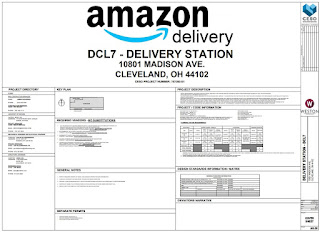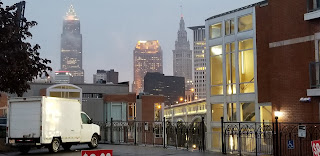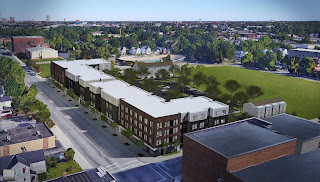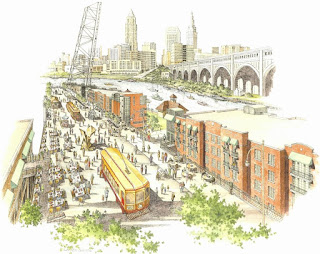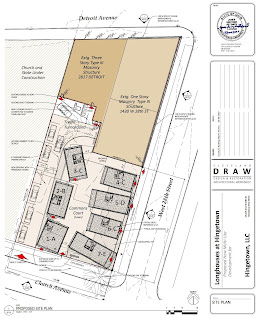The permit listing doesn't immediately give away information that the fit-out of the 168,750-square-foot building at 10801 Madison Ave. is for the E-commerce giant Amazon. But architectural drawings for the entire 21.6-acre site, added today as an attachment to the public record, certainly do give away the reason for the building permit.
Those drawings prominently display Amazon's name and logo. And it identifies the project as "DCL7." That is a code system used by Amazon to identify its delivery stations in Greater Cleveland. DCL is an abbreviation for "Delivery CLeveland."
For example, Amazon's delivery station at its Euclid Fulfillment Center uses the code DCL1, the North Randall Fulfillment Center is DCL2, North Jackson (near Canton) is DCL3, the Amazon Hub on Euclid Avenue in downtown Cleveland is DCL4, and so on up to DCL7. Not all Amazon distribution centers, such as those in Akron or Twinsburg, have delivery stations.
NEOtrans broke the news earlier this month, was identified in architectural drawings as DCL6 with "Amazon" marked on the side of the documents. There will also be a DCL5 delivery station but its location is not yet known. Sites in Bedford Heights and Parma are rumored.
Under the DCL7 permit, the work being done at the Madison Industrial Park involves only the existing building constructed last year by the Weston Group in the hopes of landing a tenant in a hot market for new warehouses. The fit-out of that structure for Amazon has as estimated price tag of $8,757,482, according to the permit.
"The proposed facility is being designed for a package delivery service," according to a project description with the drawings. "It is anticipated that the facility will have two shifts working days and evenings. There may be a third shift added at peak season."
The number of jobs possible with this site isn't described in the documents and Weston officials have not returned phone calls and e-mails seeking more details. However, the building shows a maximum occupancy of more than 1,000 people although the total number of parking spaces is 669. The facility is also within walking distance of the West 117th/Madison Red Line rapid station and several bus lines.
"Once unloaded into the facility, the packages are sorted into more specific locations, put into bins and onto small mobile carts. These carts are rolled out to the loading area, from which the packages are loaded into vans for final delivery," the description concludes.
Included in that permit is the addition of an Amazon Hub staging area, interior offices, more bathrooms, numerous conveyors and massive new parking areas for trucks, vans and cars, the public documents show.
Plans show there will be eight truck docks and 96 spaces for delivery vans with 48 of those spaces covered by a planned canopy structure. Stretching all the way south to the railroad tracks and to a stormwater retention basin, between West 106th and West 110th streets, will be an employees parking lot for 482 cars.
 |
| This is the original site plan for Weston's Madison Industrial Park. The site plan (with north at the left side) shows three buildings including the one that Weston built last year (Weston). |
That site plan provided for two additional 115,000-square-foot light-industrial/warehouse-type buildings south of the one Weston built last year. With Amazon's parking needs, those buildings cannot be built unless the new parking spaces are moved someday to another site or put into a large deck. Both of those are unlikely to happen.
The existing building already has 187 parking spaces fronting Madison and Berea Road. The additional parking areas will bring the total to 669 spaces. When it constructed the 168,750-square-foot building last year, Weston anticipated that it could accommodate about 100 employees. But the addition of 482 spaces suggests that many more jobs will be in the offing. NEOtrans first reported in March that this site would likely be for Amazon.
Given the nature of the construction involved, it is probable that the retrofitting of the existing building and construction of the parking can be completed by the end of this year. The city will also contribute to the construction work by repaving West 106th which is lined with houses along its eastern side.
"I've heard no confirmation about the end user although we all suspect who it might be," Mooney said. "Nothing has been publicly stated by the developer. When Weston said it would be delivery vans, that just confirmed for me that it (the tenant) was most likely Amazon. Weston can't say who it is because of a non-disclosure agreement."
Weston received in 2018 a 10-year property tax abatement from the city for the building at Madison Industrial Park with an estimated construction cost of $10 million. Abatement applies only to the buildings, not the land. A Weston affiliate acquired the entire 21.6-acre Madison Industrial Park site from the city of Cleveland in 2018 for $1.65 million.
 |
| Evidence of construction for Amazon is on the left, or west side of West 106th Street with residences on the right. This street will be repaved by the city later this year (KJP). |
Mooney said he received complaints from nearby residents about "all of the trucks" traveling to and from the construction site. So he spent about a half-hour today watching the site to observe the truck traffic.
"There's definitely been a parade of trucks as well as a street cleaner around the site," Mooney said. "They've started on plumbing and site drainage work."
DiGeronimo Companies' Independence Construction LLC was the building contractor for the warehouse building that was built last year. Their vehicles are the same ones working on-site now. Curt Garrett, pre-development manager at Independence Construction, paid the city's permit fees according to public records, confirming their lead role in the construction work.
Tyler Kapusta contributed to this article.
END
Tyler Kapusta contributed to this article.
END


